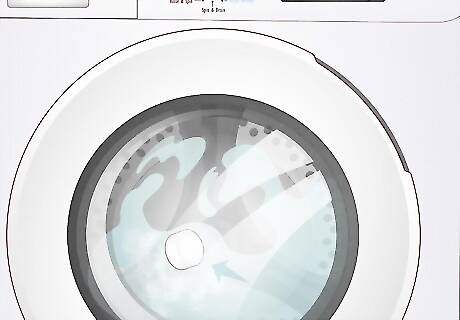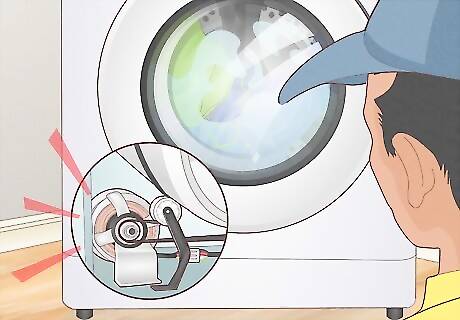
views
- Check the drain hose for kinks and blockages. The drum won’t drain if the hose isn’t completely open.
- Rearrange the clothes if the load is asymmetrical and re-level the machine if it’s lopsided.
- If you have a leak, check the supply lines and hose where they feed into the wall. If the door is leaking, replace the seal.
Whirlpool Resources

If there’s a code on the screen, look up the error code’s solution. Most modern Whirlpool machines will display an error code if they detect something wrong. These codes refer to specific errors, so pull up the error code list to find the specific solution you need. Error codes won’t always display if something is wrong. But if there is an error code, follow the steps in your manual or in our walkthrough to fix the problem.

Use the Whirlpool Troubleshooting Tool for niche problems. If you go through the steps to solve your problem and still can’t get to the bottom of it, try using Whirlpool’s Troubleshooting Tool. Simply click your type of washer, then click through the prompts to find Whirlpool’s guide for your issue. It’s possible that you have a Whirlpool model that has unique functions that create distinct problems, or your problem is so obscure that Whirlpool has created a specific guide for it.
Washing Machine Won’t Drain

Check your spin speed if the clothes are just soaked. If you don’t have a tub of water at the bottom, you probably just selected a spin speed that doesn’t put a lot of wear and tear on the clothes. The “gentle” and “delicate” cycles are the most likely to leave clothes soaked. Simply dry your clothes like normal and avoid using the low spin speed cycles in the future. There’s nothing wrong with the gentle or delicate cycles per se, but they don’t run the fast rinse rotations that pull out all the water from the clothes.

Unkink the drain hose and remove any blockages. If the cycle stopped midway and the water in the drum isn’t draining, the drain hose is likely the culprit. Follow the drain hose and undo any kinks you run into. Then, shine a flashlight down the hose to see if there are any blockages. If there are, remove them, and the water should drain out. If you can’t tell if there are any blockages, just remove the drain hose and run some water through it. If the water drains out freely, there’s no blockage. If there is a blockage and you can’t remove it by hand, snake the drain hose with a drain auger.

Lower the drain hose if it’s high off of the floor. Whirlpool drain hoses cannot be higher than 96 inches (240 cm) off of the floor and no lower than 39 inches (99 cm) from the ground. If the hose is too high or low, adjust it to the proper angle so that the water can actually flow out of the drum. If the water doesn’t automatically drain once you’ve fixed the problem, turn the machine off, wait 1 minute, and then plug it back in. If the water still won’t drain, contact an appliance repair professional.
Washing Machine Won’t Spin

Check the load to see if it’s unbalanced. Clothing should be evenly distributed inside of the drum. The clothing should also be loosely laid in the machine. If the clothing is built up on one side of the drum or you shoved the clothing down to compress it, rearrange the clothing to make it easier for the drum to spin and restart your cycle. Whirlpool machines automatically shut off if they detect a huge weight difference inside the drum.

Remove half of the clothes if you overloaded the machine. If the drum is too heavy, the washing machine won’t be able to spin the drum. The drum should only ever be about 1/2-3/4 full, so if the clothing is near the top of the drum, remove some of your clothes and restart the cycle. As tempting as it may be to get all of your laundry done at once, your clothes don’t really get clean if you pack the drum up. The water just doesn’t have enough room to flow in and out of each garment. If you want to do laundry the right way, smaller loads are the way to go.

Re-level the machine if it’s sitting on an odd angle. Put a spirit level on top of the machine to see if it’s sitting flat. If it isn’t, prop the machine up with a brick or some other small object and adjust the casters on the legs to change the machine’s height. Continue to make incremental adjustments until your machine sits perfectly flat and restart your cycle. A poorly-leveled washing machine is also likely to make a ton of noise, so if your washing machine was making banging noises recently and now it won’t run at all, it almost certainly needs to be braced after you re-level it.
Washing Machine Is Leaking

Check the hose connections and supply lines. Look on the back of the machine to find the two supply lines and the drain hose. Inspect the area where the lines and hose enter the machine to look for leaks. If there are any, either tighten the connections or replace the hose/line. Then, look where the supply lines feed into the wall. If there are any leaks, tighten the supply line nuts or replace them. Is your drain hose on the ground? It may have fallen out of the sink or drain if it wasn’t tied in place. Rescure the drain hose and vent to prevent this from happening again. The drain hose is unlikely to be the culprit unless it was torn somehow. The supply lines are much more likely to be loose or tear.

Replace the door seal if the door is leaking. Most Whirlpool machines have a door boot seal that ensures no air gets into the machine when the door is closed and locked. If water is leaking from the front of the machine, that seal is probably damaged. Find the seal for your door on Whirlpool’s website and replace the seal. Replacing the seal is typically as easy as prying the old one out by hand and forcing the new seal into place. Door seals typically need to be replaced at least once over the course of the washing machine’s life, so this is pretty normal if it has been a few years since you bought your machine.
Washing Machine Smells

Clean your washer with a cleaning tablet or white vinegar. Whirlpool recommends using Affresh cleaning tablets. You just toss one in the drum and run an empty wash. However, you can also deodorize your machine by pouring 1 cup (235 mL) of distilled white vinegar into the drum and running an empty wash. If the entire basement or area around your machine smells a little mildewy, set up a dehumidifier and turn it on whenever you run a load. The drained soap water may just be adding too much moisture to the air.

Remove your clothes immediately after the wash cycle ends. In the future, don’t leave your wet clothes to soak in the drum—always remove the clothes as soon as the washer is done running. This will keep moisture from building up in the drum and prevent your washing machine from smelling like mildew or mold.

Use less detergent if your drum smells like old soap. If you’ve got that unpleasant soap scum odor in the washing machine, run 2-3 empty cycles. Then, in the future, stop using so much detergent. Instead of reaching the fill line on the detergent container, go about halfway to the fill line. This way, the soap will fully dissolve in the water. If you’re using those detergent pods, don’t run small wash cycles. Wait until you’ve got a full load.
Washing Machine Making Noise

Ignore any clunking, grinding, or whirring that goes away. If the machine only makes noise for a minute or so and then that noise goes away, your Whirlpool machine is working normally. These temporary sounds are just the motor engaging or the drum starting to spin. It’s common for a Whirlpool to make some noise during these periods.

Contact a professional if you hear metal grinding. If you hear consistent grinding noises that sound like metal rubbing against metal, your motor is likely damaged. Reach out to an appliance repair professional to have the machine inspected and repaired. If you smell burning, unplug your machine immediately. A damaged motor may start to overheat and cause a burning smell.

Re-level the machine if you hear banging alongside shaking. If your machine isn’t level, the drum will bang repeatedly against the sides of the machine. Put a spirit level on top of the machine. Then, prop the machine up and twist the casters on the legs to adjust the height of the machine. Continue making minor adjustments until the machine is perfectly flat. If the machine is level and the drum still makes a ton of noise and bangs around during rinse cycles, your drum is probably overloaded. Stop overpacking your drum! Start using smaller loads and that banging should go away.




















Comments
0 comment